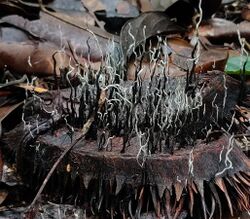Biology:Xylaria culleniae
| Xylaria culleniae | |
|---|---|

| |
| Scientific classification | |
| Domain: | Eukaryota |
| Kingdom: | Fungi |
| Division: | Ascomycota |
| Class: | Sordariomycetes |
| Order: | Xylariales |
| Family: | Xylariaceae |
| Genus: | Xylaria |
| Species: | X. culleniae
|
| Binomial name | |
| Xylaria culleniae Berk. & Broome, 1873
| |
Xylaria culleniae is a species of fungus in the family Xylariaceae. This species known to grow on dried fruits and seeds.
Taxonomy
Xylaria culleniae belongs to the family Xylariaceae.[1][2] The species grows on fruits[3] and seeds are generally considered as host-specific. This species was collected from Sri Lanka during July 1868[4] by George Gardner (botanist) and George Henry Kendrick Thwaites[5] who was superintendent of the botanical gardens at Peradeniya, Ceylon. The specimens were sent for identification to Royal Botanic Gardens, Kew[6] in 1872.[4] There English botanists and mycologists Miles Joseph Berkeley and Christopher Edmund Broome described this species in 1873.[4]
Distribution
This species is reported from Sri Lanka,[4][3] China,[7] Thailand[8][9][10] and Anaimalai Hills Southern Western Ghats, India.[11] This species is also known to occur in Central America, South America and Africa.[12]
Description
The fruit bodies are erect, elongated black branches, whitened from midway to tips. The hairs of stem is septate.[4] The ascospores (fruit bodies) of X. culleniae relatively smaller and the stromata are generally less robust. Spore dimensions are 8.5-9.5 X 3.5-4.5 μm.[12] Sporidia .016 X .005 - .006 mm.[13] Color of the spores are brown and are ellipsoid or inequilateral in shape. Germ slit is straight and long. Length of stroma is up to 7 cm.[12] Stromata unbranched or branched, cylindrical, long conical. Texture soft. Perithecia 0.1-0.3 mm diam. Ostioles minutely papillate.[10]
Hosts plants
X. culleniae are recorded growing on Cullenia exarillata pods[14] hence the species name culleniae. It is assumed to be host-specific, however it has been recorded growing on and Inga sp. fruits[12] which is a Legume. Hence their host specificity is uncertain.[15]
See also
References
- ↑ "BioLib: Biological library". https://www.biolib.cz/en/taxon/id365504/.
- ↑ U’Ren, Jana M.; Miadlikowska, Jolanta; Zimmerman, Naupaka B.; Lutzoni, François; Stajich, Jason E.; Arnold, A. Elizabeth (1 May 2016). "Contributions of North American endophytes to the phylogeny, ecology, and taxonomy of Xylariaceae (Sordariomycetes, Ascomycota)" (in en). Molecular Phylogenetics and Evolution 98: 210–232. doi:10.1016/j.ympev.2016.02.010. PMID 26903035.
- ↑ 3.0 3.1 Lloyd, C. G.; Stevenson, John A. (1920). Mycological writings of C. G. Lloyd.. 6. https://www.biodiversitylibrary.org/page/55487176. Retrieved 14 February 2022.
- ↑ 4.0 4.1 4.2 4.3 4.4 Berkeley, M. J; Broome, C.E (1875). The Journal of the Linnean Society. Botany.. 14. Longman, Green, Longman, Roberts & Green. https://www.biodiversitylibrary.org/page/237888. Retrieved 14 February 2022.
- ↑ Thwaites, George Henry Kendrick (1812–1882) on JSTOR. https://plants.jstor.org/stable/10.5555/al.ap.person.bm000154303. Retrieved 14 February 2022.
- ↑ Karunarathna, Samantha C.; Mortimer, Peter E.; Xu, Jianchu; Hyde, Kevin D. (2017). "Overview of Research of Mushrooms in Sri Lanka" (in en). Revista Fitotecnia Mexicana 40 (4): 399–403. doi:10.35196/rfm.2017.4.399-403. https://www.redalyc.org/journal/610/61054247004/html/. Retrieved 14 February 2022.
- ↑ Huang, Gu; Guo, Lin; Liu, Na (19 November 2014). "Two new species of Xylaria and X. diminuta new to China". Mycotaxon 129 (1): 149–152. doi:10.5248/129.149.
- ↑ Pan, Xiao-Yan; Song, Zi-Kun; Qu, Zhi; Liu, Tie-Dong; Ma, Hai-Xia (1 December 2022). "Three new Xylaria species (Xylariaceae, Xylariales) on fallen leaves from Hainan Tropical Rainforest National Park" (in en). MycoKeys 86: 47–63. doi:10.3897/mycokeys.86.71623. ISSN 1314-4049. PMID 35095304.
- ↑ Hsieh, Huei-Mei; Lin, Chun-Ru; Fang, Mei-Jane; Rogers, Jack D.; Fournier, Jacques; Lechat, Christian; Ju, Yu-Ming (1 March 2010). "Phylogenetic status of Xylaria subgenus Pseudoxylaria among taxa of the subfamily Xylarioideae (Xylariaceae) and phylogeny of the taxa involved in the subfamily" (in en). Molecular Phylogenetics and Evolution 54 (3): 957–969. doi:10.1016/j.ympev.2009.12.015. ISSN 1055-7903. PMID 20035889. https://www.sciencedirect.com/science/article/abs/pii/S1055790309005211. Retrieved 14 February 2022.
- ↑ 10.0 10.1 Mekkamol S. 1998. Endophytic fungi of Tectona grandis L (Teak). PhD Thesis, Liverpool John Moores University, Liverpool, UK.
- ↑ Raman, T. R. Shankar (10 January 2022). "Xylaria culleniae" (in en). https://www.inaturalist.org/observations/104693540.
- ↑ 12.0 12.1 12.2 12.3 Rogers, Jack D. (29 January 2011). "Xylaria magnoliae sp.nov. and comments on several other fruit-inhabiting species" (in en). Canadian Journal of Botany 57 (8): 941–945. doi:10.1139/b79-115. https://cdnsciencepub.com/doi/abs/10.1139/b79-115?journalCode=cjb1. Retrieved 14 February 2022.
- ↑ Cooke, M.C. (1883). On Xylaria and its allies. Grevillea. Volume XI. No. 59. Page. 83
- ↑ Ma, Hai-Xia; Song, Zi-Kun; Pan, Xiao-Yan; Qu, Zhi; Ma, Si-Yu; Yang, Zhan-En; Zhang, Bo; Li, Yu (14 February 2022) (in en). Phylogeny and Taxonomic of Xylaria Associated With Fallen Fruits and Seeds in China. doi:10.21203/rs.3.rs-1081502/v1. https://www.researchsquare.com/article/rs-1081502/v1. Retrieved 14 February 2022.
- ↑ Ju, Yu-Ming; Rogers, Jack D.; Hsieh, Huei-Mei (4 July 2018). "Xylaria species associated with fallen fruits and seeds". Mycologia 110 (4): 726–749. doi:10.1080/00275514.2018.1469879. ISSN 0027-5514. PMID 30067469. https://www.tandfonline.com/doi/abs/10.1080/00275514.2018.1469879. Retrieved 14 February 2022.
External links
Wikidata ☰ Q10723084 entry
 |

